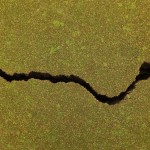New Study Finds Another Link Between Drilling and Earthquakes
A new study shows yet another link between oil and gas drilling and manmade earthquakes in Texas. The report, by scientists at the University of Texas at Austin, says that a recent string of quakes in the Eagle Ford Shale formation of South Texas are mostly a result of oil and gas drilling.
“The question we were looking at was, were quakes in the area linked to the disposal of hydrofracking waste?” says Cliff Frohlich, Associate Director at UT’s Institute for Geophysics and lead author of the study.
In previous studies of earthquakes in the Barnett Shale drilling in the Dallas-Fort Worth area, the science pointed to disposal wells as the culprit, where large amounts of wastewater from drilling are disposed of deep underground. In the case of South Texas, another drilling hotspot, Frohlich was expecting the same result.
But the geology and drilling history of the Eagle Ford are different, Frohlich says. Although the new study finds that some of the quakes in the area are probably linked to injection disposal wells, most of them, especially the biggest ones, are linked to the extraction of oil and gas.
“What I found was, almost all the interesting [quakes] were not near sights of injection, they were near sites of production,” Frohlich says. “That is, people were pulling more fluid, oil and water out of the ground than they were injecting.”
When oil comes out of the ground during the drilling process, it isn’t alone. The oil has to be separated from large volumes of what is called “produced water,” i.e. water produced as a byproduct of drilling. It is generally dirty and ill-suited for drinking or irrigation, so the typical industry practice is to dispose of it deep underground, where it has been known to cause quakes in parts of Texas.
But take out enough fluids — the extraction — and the absence of that oil and produced water can cause quakes as well, the new study says. In the case of the Eagle Ford shale area, Frohlich found that 47 of 62 quakes from November 2009 to September 2011 were likely due to extracting large volumes of oil and produced water from the ground.
“There’s famous stories in mining, where people mine in an area and then things collapse, and the collapse is just a little earthquake,” says Frohlich. “So if you’re removing fluids, it’s changing the stresses locally. It’s also changing the stresses on faults. So either removing or adding fluids can cause earthquakes.”
The quakes in the Eagle Ford and Barnett shales are generally small and have not done extensive damage. But their frequency and intensity in areas previously thought to be seismically quiet has disturbed locals and at times overwhelmed 911 centers with calls. One of the largest of the quakes in the Eagle Ford, in Fashing, occurred after the time studied, October 20, 2011. That quake measured 4.8 and was felt as far away as San Antonio.
“That area where that earthquake occurred is exactly an area where there’s been continuing extraction,” Frohlich says, noting that wells in Fashing are likely also responsible for earlier earthquakes noted in the seventies and nineties.
It’s not just big quakes getting attention anymore. In their research, Frohlich and others have found many more smaller quakes that are going unnoticed, thanks to an array of monitors slowly making their way across the country with funding from the National Science Foundation.
“Little earthquakes are more common than big earthquakes,” Frohlich says. “So if you want to study a phenomenon, you get more data and statistics.”
With those more robust sources of data, in both the Barnett and Eagle Ford shales, Frohlich says the links between drilling and quakes are convincing, even if they happen to be different factors at play depending on the geology.
“What scientists and policy makers would like is a silver bullet,” Frohlich says, to have just one aspect of drilling to blame for the manmade quakes. “Of course, science and life don’t work like that.” While his research shows disposal wells behind quakes in the Barnett, it also shows extraction as the culprit in the Eagle Ford.
“Silver bullets are hard to find,” he says. “It’s just more complicated than one had hoped.”
Disclosure: StateImpact Texas is part of KUT Austin, a unit of the University of Texas at Austin.

